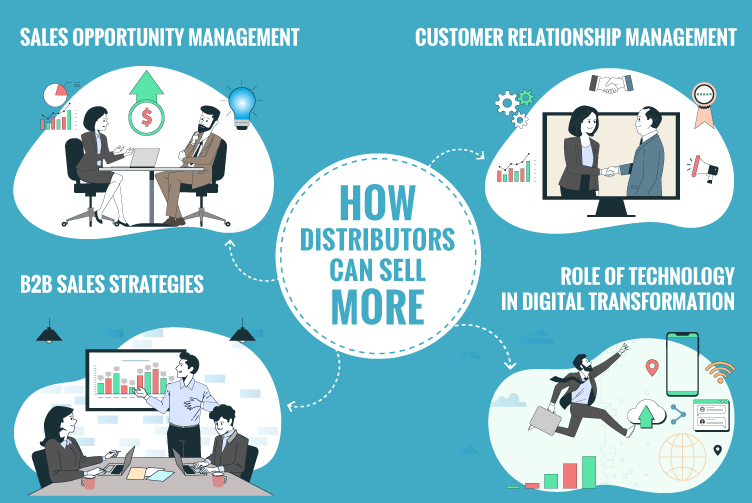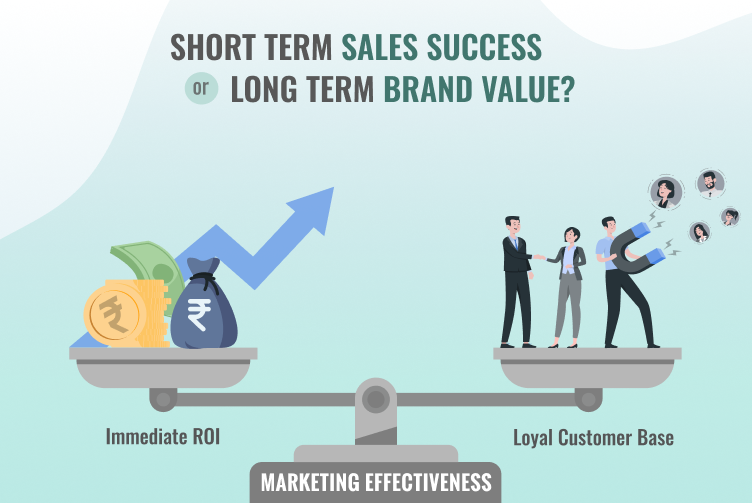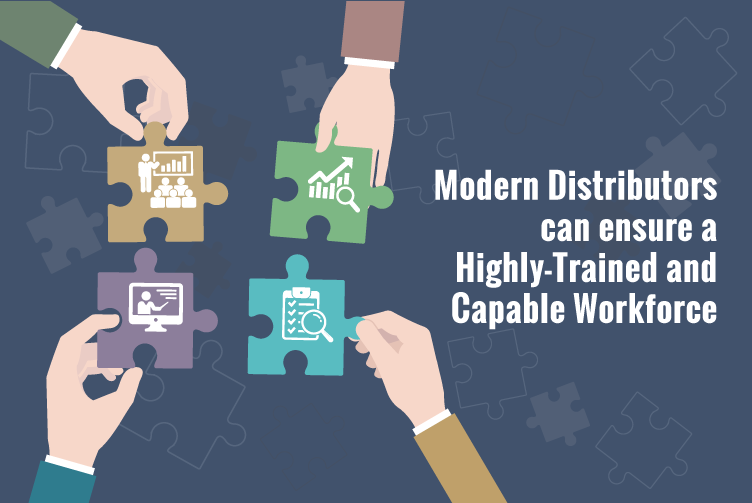For distribution-focused companies across the globe, the post-pandemic phase is not translating to “going back to the normal.” The supply chain challenges of the global pandemic along with changing customer expectations mean that distributors will continue to face disruptions to their ways of working.
For one, B2B eCommerce increased by 17.8% to surpass $1.63 trillion in 2021 and is set to grow in 2022. Having said that, less than one-quarter of B2B companies are equipped to leverage digital tools and technologies in 2022. B2B distributors need a “digital-first” approach to keep pace with the changing demands of the marketplace.
How can distribution companies take advantage of digital technologies and sell more products to their customers?
Here are some key focus areas.
Sales Opportunity Management
Using sales opportunity management, distributors can track their sales opportunities through the entire sales pipeline. Effectively, opportunities are leads (or potential customers) that have shown interest in offered products (or services) and are ready to purchase them.
Here are 5 signs that strongly indicate the need for sales opportunity management:
- When it is difficult to prioritize sales opportunities.
- When the overall value of the available sales opportunities at any time is not known.
- When the ratio between won and lost opportunities is not known.
- When sales opportunities are progressing slowly through the sales funnel.
- When it is challenging for executives to determine the next step.
Effectively, sales opportunity (or pipeline) management enables distributors to prioritize the most-likely deals and achieve their sales goals. Here are some of the best practices of opportunity management:
- Set up a well-defined sales pipeline with a visual representation of the various stages of the sales process.
- Understand each sale lead along with their intent before creating the pipeline.
- Be in touch with sales leads consistently using various tools including newsletter subscriptions, webinars, phone calls, or product demos.
- Follow up with sales leads regularly using behavior tracking and provide a good and positive user experience with your brand.
- Identify and focus on the best leads using metrics such as buying intent, content engagement, and more.
- Review the sales pipeline regularly and make incremental changes.
- Shorten the B2B sales cycle and reduce the follow-up time when communicating with leads. Customized product demos can further shorten the sales cycle.
- Standardize the sales procedure for leads with the same buyer persona.
- Offer relevant product content to engage with opportunities.
Customer Relationship Management (CRM)
Both B2C and B2B enterprises are now heavily investing in CRM tools and systems. In the B2B space, it is more important for companies to correctly invest in CRM tools and their usage. Effectively, a CRM is all about managing customer relations using a single system. With the B2B sales cycle being more complicated and involving multiple touchpoints, distributors need an efficient CRM strategy to improve brand visibility and productivity.
The correct CRM strategy is effective for discovering loopholes in the B2B and B2C sales process and implementing methods to increase sales. Besides, marketing teams can use CRM to capture incoming sales leads, launch marketing campaigns, move their leads through the pipeline, and convert leads into loyal customers.
Here are a few benefits of CRM for any distribution company:
- Manage the entire sales cycle using a single solution.
- Improve efficiency by documenting all customer-related information including that of sales leads, prospects, contacts, and existing customers within a single CRM database.
- Use CRM collaboration tools to document and store every customer interaction and provide a proper customer response.
- Leverage CRM automation to automate manual sales-related tasks like sending reminders for upcoming payments.
B2B Sales Strategies
B2B sales process has radically changed in recent years with only 17% of the buying process spent on meeting with potential distributors. Further, only 29% of buyers now talk to sales personnel to learn about products, while over 50% of the purchase decisions are completed before buyers call up a potential supplier.
Recent research studies have shown that over 60% of B2B consumers are young and tech-savvy millennials, followed by 32% of Generation X (aged over 40 years). This means that a majority of B2B consumers conduct their research using resources like product demos, vendor websites, user reviews, and free product trials.
Considering these trends, B2B distributors must adopt marketing strategies around digital channels. Here are a few steps as a part of an effective B2B sales strategy:
- Determine how the B2B brand is perceived by the customer.
- Identify the target audience for the brand’s products or services.
- Perform competitive analysis to check how competitors are marketing to this target audience.
- Explore the marketing channels where B2B distributors can reach their audience.
How do digital technologies play a part in digital transformation?
Role of Technology in Digital Transformation
Following the disruption caused by the pandemic, distribution leaders are now looking to grow their business using digital transformation. Companies are looking to adopt the latest technologies relevant to their customer base and their unique challenges.
By leveraging digital technologies, successful distributors have created value for their customers, built a competitive advantage, and achieved growth. Besides eliminating customer pain points, digital transformation goes beyond to provide a fulfilling customer experience. For instance, digital technologies like AI, IoT, and Blockchain are being deployed to collect customer data and extract insights for business effectiveness.
A successful digital transformation strategy is all about putting customers and employees first and understanding their needs and challenges.
Conclusion
In the aftermath of the pandemic, B2B distributors are now accelerating their transition to a “digital-first” approach to growing their business.
At Amshuhu iSteer, we believe in delivering distributor solutions that can help in integrating all aspects of their business operations. Our iSteer Sales Channel solution is designed to boost sales productivity and efficiency that can improve B2B sales lead conversion and revenues. Learn how to sell more with our opportunity management and CRM solutions? Contact us today.




